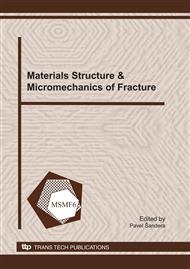p.137
p.141
p.145
p.149
p.153
p.157
p.161
p.165
p.169
Damage of Multilayer Polymer Materials under Creep Loading
Abstract:
Failure of layered materials is frequently caused by the existence of interfaces between single layers. In structures loaded by long-term constant stress the damage can be described on micro-scale by material changes due to active creep mechanism and at the macro-level by a corresponding change of the stress and strain field. In the contribution the behavior of a crack propagating through the interface is analyzed. Primary attention is devoted to a crack with its tip at the interface under creep exposition. The step change of material properties at the bi-material interface means that standard fracture mechanics access is not applicable and a modified approach based on generalization of the classical concept has to be used. The approach is illustrated on the damage of a plastic pipe with protective layer.
Info:
Periodical:
Pages:
153-156
Citation:
Online since:
January 2011
Authors:
Keywords:
Price:
Сopyright:
© 2011 Trans Tech Publications Ltd. All Rights Reserved
Share:
Citation:


